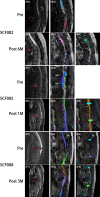Partial restoration of spinal cord neural continuity via vascular pedicle hemisected spinal cord transplantation using spinal cord fusion technique
- PMID: 35545932
- PMCID: PMC9253790
- DOI: 10.1111/cns.13853
Partial restoration of spinal cord neural continuity via vascular pedicle hemisected spinal cord transplantation using spinal cord fusion technique
Abstract
Aims: Our team tested spinal cord fusion (SCF) using the neuroprotective agent polyethylene glycol (PEG) in different animal (mice, rats, and beagles) models with complete spinal cord transection. To further explore the application of SCF for the treatment of paraplegic patients, we developed a new clinical procedure for SCF called vascular pedicle hemisected spinal cord transplantation (vSCT) and tested this procedure in eight paraplegic participants.
Methods: Eight paraplegic participants (American Spinal Injury Association, ASIA: A) were enrolled and treated with vSCT (PEG was applied to the sites of spinal cord transplantation). Pre- and postoperative pain intensities, neurologic assessments, electrophysiologic monitoring, and neuroimaging examinations were recorded.
Results: Of the eight paraplegic participants who completed vSCT, objective improvements occurred in motor function for one participant, in electrophysiologic motor-evoked potentials for another participant, in re-establishment of white matter continuity in three participants, in autonomic nerve function in seven participants, and in symptoms of cord central pain for seven participants.
Conclusions: The postoperative recovery of paraplegic participants demonstrated the clinical feasibility and efficacy of vSCT in re-establishing the continuity of spinal nerve fibers. vSCT could provide the anatomic, morphologic, and histologic foundations to potentially restore the motor, sensory, and autonomic nervous functions in paraplegic patients. More future clinical trials are warranted.
Keywords: GEMINI; clinic trial; polyethylene glycol; spinal cord fusion; spinal cord injury.
© 2022 The Authors. CNS Neuroscience & Therapeutics published by John Wiley & Sons Ltd.
Conflict of interest statement
The authors declare that they have no conflict of interest.
Figures







Similar articles
-
Developing preclinical dog models for reconstructive severed spinal cord continuity via spinal cord fusion technique.IBRO Neurosci Rep. 2024 Apr 29;16:560-566. doi: 10.1016/j.ibneur.2024.04.006. eCollection 2024 Jun. IBRO Neurosci Rep. 2024. PMID: 38764541 Free PMC article.
-
Partial Restoration of Spinal Cord Neural Continuity via Sural Nerve Transplantation Using a Technique of Spinal Cord Fusion.Front Neurosci. 2022 Feb 14;16:808983. doi: 10.3389/fnins.2022.808983. eCollection 2022. Front Neurosci. 2022. PMID: 35237120 Free PMC article.
-
Transplantation of a vascularized pedicle of hemisected spinal cord to establish spinal cord continuity after removal of a segment of the thoracic spinal cord: A proof-of-principle study in dogs.CNS Neurosci Ther. 2021 Oct;27(10):1182-1197. doi: 10.1111/cns.13696. Epub 2021 Jun 28. CNS Neurosci Ther. 2021. PMID: 34184402 Free PMC article.
-
Fusogen-assisted rapid reconstitution of anatomophysiologic continuity of the transected spinal cord.Surgery. 2016 Jul;160(1):20-25. doi: 10.1016/j.surg.2016.03.023. Epub 2016 Apr 29. Surgery. 2016. PMID: 27138179 Review.
-
Transplants and neurotrophic factors increase regeneration and recovery of function after spinal cord injury.Prog Brain Res. 2002;137:257-73. doi: 10.1016/s0079-6123(02)37020-1. Prog Brain Res. 2002. PMID: 12440372 Review.
Cited by
-
A novel strategy for spinal cord reconstruction via vascularized allogeneic spinal cord transplantation combine spinal cord fusion.CNS Neurosci Ther. 2024 Sep;30(9):e70020. doi: 10.1111/cns.70020. CNS Neurosci Ther. 2024. PMID: 39312474 Free PMC article.
-
Stem Cell Strategies in Promoting Neuronal Regeneration after Spinal Cord Injury: A Systematic Review.Int J Mol Sci. 2022 Oct 27;23(21):12996. doi: 10.3390/ijms232112996. Int J Mol Sci. 2022. PMID: 36361786 Free PMC article.
-
Developing preclinical dog models for reconstructive severed spinal cord continuity via spinal cord fusion technique.IBRO Neurosci Rep. 2024 Apr 29;16:560-566. doi: 10.1016/j.ibneur.2024.04.006. eCollection 2024 Jun. IBRO Neurosci Rep. 2024. PMID: 38764541 Free PMC article.
-
Application of"Spinal cord fusion" in spinal cord injury repair and its neurological mechanism.Heliyon. 2024 Apr 9;10(8):e29422. doi: 10.1016/j.heliyon.2024.e29422. eCollection 2024 Apr 30. Heliyon. 2024. PMID: 38638967 Free PMC article. Review.
References
Publication types
MeSH terms
Substances
LinkOut - more resources
Full Text Sources
Medical

